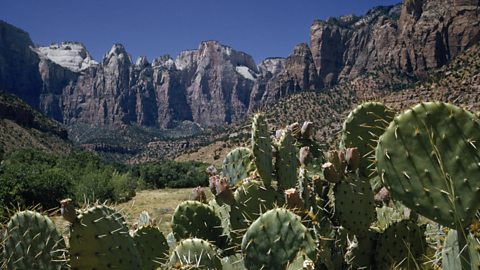Plant adaptations - xerophytic
Plants with adaptations which allow them to live in hot and dry conditions are called xerophyticA type of plant that has adapted to living in a dry habitat such as a desert.. The following adaptationA feature of an organism's body which helps it to survive. allow plants to survive in the hot desert environment:
- Small leaves - these ensure that less water is lost from the plant by transpirationThe loss of water from leaves by evaporation through the stomata. because the leaf has a smaller surface area.
- Tap roots - these are long roots (7-10 metres long) that reach deep under the ground to access water supplies. The tap roots are much longer and bigger than the plant which is visible at the surface.
- Spines - some plants have spines instead of leaves eg cacti. Spines lose less water than leaves so are very efficient in a hot climate. Spines also prevent animals from eating the plant.
- Waxy skin - some leaves have a thick, waxy skin on their surface. This reduces water loss by transpirationThe loss of water from leaves by evaporation through the stomata..
- Water storage - some plants, known as succulents, store water in their stems, leaves, roots or even fruits. Plants which store water in their leaves and stems also have a thick waxy skin so that they lose less water by transpiration.

Image caption, Cacti
Cactus plants have spines to reduce water loss.
Image caption, Succulents
Succulents store water in their stems.
Image caption, Tap roots
Plants like these have long tap roots to reach water deep beneath the ground.
1 of 3
End of image gallery